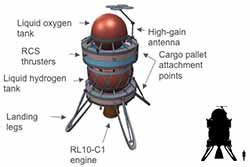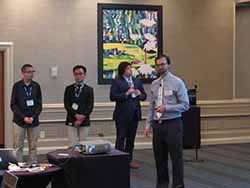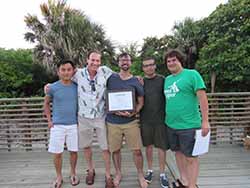Student team presents winning design at NASA RASC_AL Competition

Drawing of AEM student team Lunar orbit transfer tug

University of Minnesota Team during their final presentation.

University Of Minnesota Team receiving their award for 1st place in the Lunar Mining theme at the RASC_AL awards celebration. Left to right names: Mike Wang, Patrick Troutman (NASA competition sponsor from NASA Langley Research Center), Alexander Halaszyn, Karl Thompson, and Mathew Eller.
The AEM Department is proud to announce that a senior design team from AEM 4333, the Scalable Lunar Ice Propellant Manufacture through Modularity team, took home a first place award at the NASA RASC_AL collegiate design and innovation challenge. The NASA competition took place in Cocoa Beach, FL on June 21-23 and included 12 college teams—nine teams of undergraduates and three teams of graduate students. Students on the teams hailed from 21 different colleges and universities from the United States, Europe, and Australia. The University of Minnesota design team, which consisted of Alexander Halaszyn, Karl Thompson, Mathew Eller, and Mike Wang, competed in the Lunar Ice-Trap ISRU Mining, Processing, and Storage Infrastructure theme. See below for the Lunar Mining theme problem statement provided by NASA.
The AEM student design team spent the fall 2015 semester translating the problem statement into a set of requirements, creating a preliminary design, and writing an abstract that was then evaluated by NASA as an entrance criterion for the next stage of the competition. The Minnesota design team was selected to proceed to the mid-project review paper submittal. The team began the spring 2016 semester with preparing their mid-project report, and upon its evaluation, the team was honored with the opportunity to complete a full design report and present their design at the NASA hosted RASC_AL innovation conference in June 2016. The team used the remainder of the spring semester to add significantly more detail to the design, write the final report, prepare the competition presentation, and develop a poster summary of the project. Key innovations in their Lunar Mining design included: 1) an orbital transfer vehicle, The Tug; 2) small interchangeable nuclear power; 3) interchangeable rover toolsets; and 4) a universal connector for power, communications and fluid/gas transfer.
At the RASC_AL competition, the team participated in three days of presentations and poster sessions and a tour of the Kennedy Space Center (KSC). The team also had the opportunity to attend a SPACEX hosted tour of their new launch facility at Pad 39A at KSC—the historic launch pad that all of the Apollo and Space Shuttle missions used. On the morning of June 23, the Minnesota team made their 30 minute design presentation. After the presentation, they went into their poster session and answered many detailed questions from the set of NASA and industry judges. AEM Industrial Professor of Design and design team adviser, John Weyrauch, said, “The team did a great job of presenting their design and an absolutely fabulous job of answering the poster session questions. Their in-depth knowledge of all aspects of their design was clear to all.”
Even more impressive, the AEM senior design team was awarded first place in the Lunar Mining theme and was the only undergraduate team to receive an award at the competition. The team was presented a nice plaque from NASA at the awards celebration. Professor Weyrauch recounts, “The AEM students received many compliments from both judges and faculty advisers from other teams on their innovative design and their in depth knowledge of the technologies they proposed. Just like last year, the student team definitely encourages the department to participate in the competition again next year.”
Special thanks to Professor Weyrauch for his contributions to this article.
NASA Lunar Mining Theme Problem Statement
Given a 10-20 year timespan starting in 2015, and a flat total NASA budget of $16 Billion a year, derive a lunar ice-trap plant and associated systems. Previous studies have indicated the possible utility of lunar resources for missions to Mars. Humans may be able to mine, process, and store the ice trapped in the cold and permanently shadowed craters at the lunar poles. To enable such an architecture, it is necessary to understand the systems and operational requirements for developing, deploying and operating a resource production plant on the moon. Within the architecture, teams must design the transportation systems that deliver the ISRU infrastructure (i.e., plant) to the moon, but NOT the transportation system that will ultimately utilize the products. Teams will propose a plant that:
- Is capable of producing a minimum 100t of oxygen/hydrogen propellant annually, and is scalable to significantly larger levels of production
- Has a power source capable of operating the resource collection, processing, product storage and other required systems
- Is autonomous
- Systems can begin launching as early as 2025. By 2035, an infrastructure should in place that is producing 100t of oxygen/hydrogen propellant annually.


